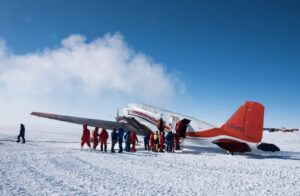“Our skin-sewed Fin-boats lightly swim,
Over the seas like wind they skim.
Our ships are built without a nail;
Few ships like ours can row or sail.”
12th century Viking saga
Viking sagas talk of the Finnmen’s legendary seafaring skills and how they made epic ocean voyages in sealskin boats known as qajaqs.
James Wallace, a minister from Kirkwall, first reported Inuit kayakers off northern Scotland in 1682. More than 40 years later, an Inuk washed ashore on a beach near Aberdeen, alone and exhausted. The man died three days later. His boat, made from sealskin, bone and driftwood, is now preserved in a local museum, along with his hunting equipment.

Around the same time, a number of Finnmen were sighted near the Orkney Islands, in northern Scotland.
Norman Roger’s 2012 book, Searching for the Finmen, recounts these sightings and various theories about where they came from and how they may have reached Scotland.
The book inspired accomplished British paddler Patrick Winterton and his friend, Olly Hicks, to begin plotting a similar expedition. Their purpose was to try and shed light on whether the Finnmen could indeed have made such a journey. Winterton eventually declined to make the trip, so Hicks asked George Bullard to join him. “People didn’t believe the Finnmen could have crossed freezing waters in such fragile craft,” Bullard explains.

The route taken by Hicks and Bullard from Greenland to Scotland. Map: Olly Hicks
The pair set out in 2016 from Knighton Bay, on the southeast coast of Greenland, and kayaked 1,930km across the North Atlantic to Scotland, thereby retracing a potential route taken by the Finnmen almost three centuries ago. They braved some of the most dangerous waters on the planet and had a huge slice of luck, which not only saved their lives but aided them in their quest to explore history.
Click on the link below to view the film of Hicks’ and Bullard’s journey:
https://www.redbull.tv/video/AP-1NBYKYF9W1W11/voyage-of-the-finnmen






